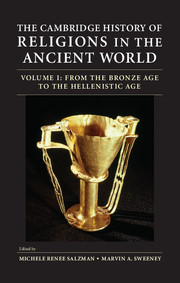Book contents
- Frontmatter
- Contents
- List of Figures and Maps
- List of Contributors
- List of Abbreviations
- Acknowledgments
- Introduction to Volumes I and II
- Introduction to Volume I
- Part I Mesopotamia and the Near East
- Part II Egypt and North Africa
- Part III Greece and the Eastern Mediterranean
- Part IV The Western Mediterranean and Europe
- Suggestions for Further Reading
- General Index
- Index of Citations
- Frontmatter
- Contents
- List of Figures and Maps
- List of Contributors
- List of Abbreviations
- Introduction to Volume II
- Part I Iran and the Near East
- Part II Egypt and North Africa
- Part III Greece and Asia Minor
- Part IV Italy, Roman Gaul, and Spain
- 14 Religion in Rome and Italy from the Late Republic through Late Antiquity
- 15 Judaism in Italy and the West
- 16 Christianity in Italy
- 17 Religions and Cities in Roman Gaul (First to Fourth Centuries CE)
- 18 Christianity in Gaul
- 19 Religions of Roman Spain
- Suggestions for Further Reading
- General Index
- Index of Citations
- References
17 - Religions and Cities in Roman Gaul (First to Fourth Centuries CE)
from Part IV - Italy, Roman Gaul, and Spain
Published online by Cambridge University Press: 05 October 2013
- Frontmatter
- Contents
- List of Figures and Maps
- List of Contributors
- List of Abbreviations
- Acknowledgments
- Introduction to Volumes I and II
- Introduction to Volume I
- Part I Mesopotamia and the Near East
- Part II Egypt and North Africa
- Part III Greece and the Eastern Mediterranean
- Part IV The Western Mediterranean and Europe
- Suggestions for Further Reading
- General Index
- Index of Citations
- Frontmatter
- Contents
- List of Figures and Maps
- List of Contributors
- List of Abbreviations
- Introduction to Volume II
- Part I Iran and the Near East
- Part II Egypt and North Africa
- Part III Greece and Asia Minor
- Part IV Italy, Roman Gaul, and Spain
- 14 Religion in Rome and Italy from the Late Republic through Late Antiquity
- 15 Judaism in Italy and the West
- 16 Christianity in Italy
- 17 Religions and Cities in Roman Gaul (First to Fourth Centuries CE)
- 18 Christianity in Gaul
- 19 Religions of Roman Spain
- Suggestions for Further Reading
- General Index
- Index of Citations
- References
Summary
“Roman domination imposed on Gaul both foreign masters and new styles of governance. Among its habitants, it brought about changes in their way of life, of work, and of material advancement; with the appearance of towns, roads, and monuments, it reshaped the land. But it did even more than that: it altered the beliefs of the people, their language, ways of thinking, and customs. In addition to material transformations of the country, it brought about a revolution in morals.” (Jullian, Histoire de la Gaule, vol. 2, 133)
Introduction: Territorial and Religious Diversity
At the outset, we must clarify our terminology and the geographic area under consideration. Even if the Romans speak readily of “Gaul” and the “Gauls” to describe the territories extending from the Pyrenees to the Rhine, this generic terminology, as recent studies of the Iron Age have demonstrated, masks great local and regional diversity, the evolution of which was shaped in various ways by the Celtic migrations. In effect, the “Gauls” did not exist apart from the reductionist mentality of the conquering Romans. The Romans could not entirely overlook the diversity, however. In the interior of “long-haired Gaul” (Gallia Comata), Caesar clearly differentiates the Belgae from the Celts and the Aquitani: “All these people,” he states, “differ from one another in speech, customs, and laws.”
Beginning with the reign of Augustus Caesar, the Tres Provinciae Galliae (as the delegates of the cities assembled at the altar of the Lyon Confluence signed their decree) ultimately became the official designation of the three new provinces of Aquitania, Lugdunensis (Lyonnaise), and Belgica. Gallia Transalpina, which was conquered in the second century BCE and which merged the regions of the Midi, received the name Gallia Narbonensis (Narbonnaise). A land of colonies and Latin civitates, the Midi, stretching from Narbonne to the Alps, was integrated into the empire at an earlier date. Geographically close to Italy, the Midi did not share the same history as the interior of Gaul conquered by Caesar between 58 and 51 BCE. (See Map 9.)
- Type
- Chapter
- Information
- The Cambridge History of Religions in the Ancient World , pp. 446 - 483Publisher: Cambridge University PressPrint publication year: 2013
References
- 1
- Cited by



